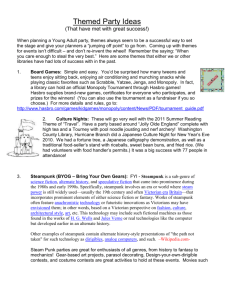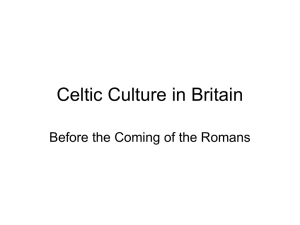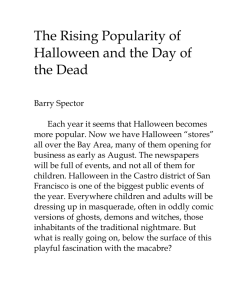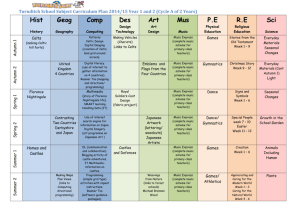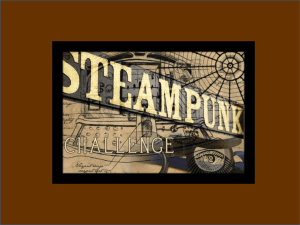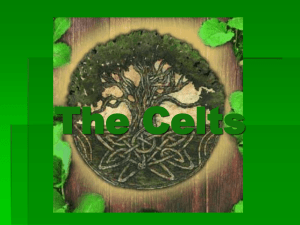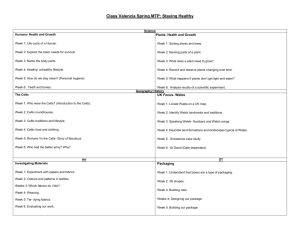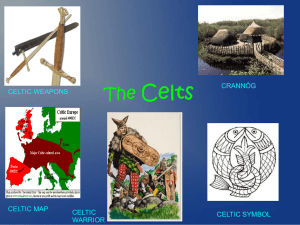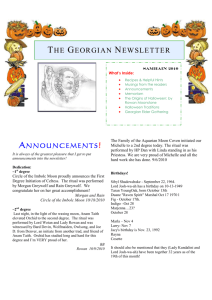2011 Samhain - The Georgian Wicca Tradition
advertisement
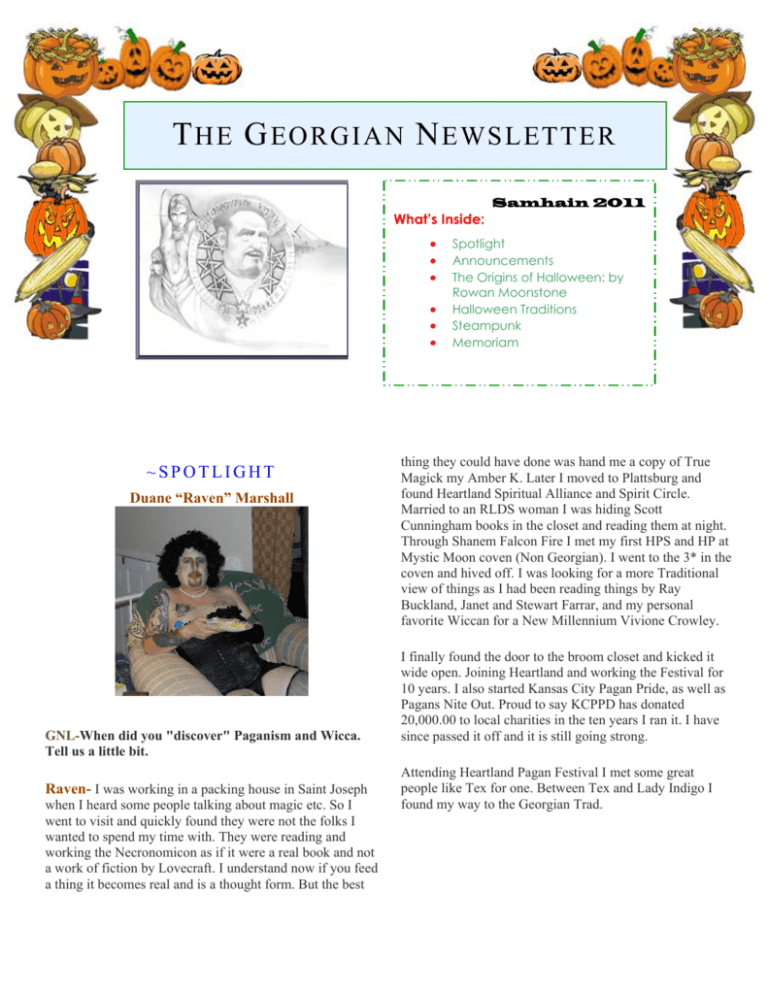
T HE G EORGIAN N EWSLETTER Samhain 2011 What’s Inside: ~SPOTLIGHT Duane “Raven” Marshall GNL-When did you "discover" Paganism and Wicca. Tell us a little bit. Raven- I was working in a packing house in Saint Joseph when I heard some people talking about magic etc. So I went to visit and quickly found they were not the folks I wanted to spend my time with. They were reading and working the Necronomicon as if it were a real book and not a work of fiction by Lovecraft. I understand now if you feed a thing it becomes real and is a thought form. But the best Spotlight Announcements The Origins of Halloween: by Rowan Moonstone Halloween Traditions Steampunk Memoriam thing they could have done was hand me a copy of True Magick my Amber K. Later I moved to Plattsburg and found Heartland Spiritual Alliance and Spirit Circle. Married to an RLDS woman I was hiding Scott Cunningham books in the closet and reading them at night. Through Shanem Falcon Fire I met my first HPS and HP at Mystic Moon coven (Non Georgian). I went to the 3* in the coven and hived off. I was looking for a more Traditional view of things as I had been reading things by Ray Buckland, Janet and Stewart Farrar, and my personal favorite Wiccan for a New Millennium Vivione Crowley. I finally found the door to the broom closet and kicked it wide open. Joining Heartland and working the Festival for 10 years. I also started Kansas City Pagan Pride, as well as Pagans Nite Out. Proud to say KCPPD has donated 20,000.00 to local charities in the ten years I ran it. I have since passed it off and it is still going strong. Attending Heartland Pagan Festival I met some great people like Tex for one. Between Tex and Lady Indigo I found my way to the Georgian Trad. The Georgian Newsletter Page 2 GNL-What tradition did you start in? if any? Raven- I have been a Georgian since 2009 if you go by my Raven- Georgian is first Trad but I was involved in First Degree Initiation date….but I have been on Georgian Chat for a very long time. I was another coven before working with the first incarnation of my current coven. GNL- Children? (how many?), grandchildren? GNL-Are you a Georgian inititiate? Raven- I have two amazing daughters and one awesome step-son (but we do not use the term step in my house) Raven-Yes I received my First Degree by Lady Indigo and Lord Lavender (Crone Moon) on 28 Feb 2009 and my Second Degree by Lady Hazel and Lord Lavender (Waxing Moon) on 28 Aug 2010 My oldest is a junior at Park U in Parkville as a photo journalism major. She is doing great and takes some wonderful shots GNL- How long have you been interested in the craft? My youngest is a junior at Plattsburg HS and owns a dance studio, member of Student Government (VP) and wants to be a Neo-natal nurse. Raven- I think I have always been interested in the Occult as a small child. While I was younger I heard voices. Wee bit frightening as a kid to hear a voice from the basement saying “There is nowhere to run…we will get you” I later learned that it was my local Amway distributor and they were right. I did deal in Amway for a short amount of time. But I have been surrounded by things for a long time. Was it my age? My almost obsessed interest in vampires and vampire lore? Don’t know I blame my Venus in Scorpio for that one. Hello Ladies…my email address is…LOL. I don’t know exactly what age I became interested in the right hand path of Witchcraft. I do know like a few others in their teen age years I was mad and pissed off at the church and what I saw to be hypocritical bullshit. I studied and read on the Left Hand Path of things. Could that have something to do with the feeling I was followed a lot and a eerie creepy feeling as I drove around at night. Sure…I will not discount it. A pissed off angry teenager who thinks they have all the answers can be a dangerous thing (to themselves). I felt that if God was bullshit then what better way to piss him off then to go bat for the other side. Be careful what you lend your energies to…it will not become you. You will become it. Having come to grips with a few things and understanding that I do in fact create my own reality, and I AM the physical manifestation of the Gods. I have learned quite a few things. I have created a symbol I wear to remind me of where I have been and where I am headed. I have included it in this spotlight at the end. GNL- How long have you been a Georgian? Who damned you to this trad? <g> My “step” son is in kindergarten and hopes to make it to the first grade. Where he can learn to be just like Spiderman, Wolverine, or Green Lantern GNL-Describe your life a little these days, what great is going on? GNL- I am not as active in the “Pagan Community” as I once was. I am ok with this really. I guess I am a bit jaded. I am very happy for the things I was involved with but really just want to focus on my family, myself and my coven. In that order. I think it is a healthy way to look at things. I have been at my current job for 18 years and will be till I win the lottery or I pass whichever comes first. I have recently become a Master Mason in Overland Park Lodge 436 and I really do enjoy it. For those that are Masons I had to chuckle at the majority of my Entered Apprentice Degree. Those that have been through it will understand. So these days you will find me at work, Coven or Lodge. Any really good stories you fondly remember or shiver at the thought of these days you might wanna share with us? I was in the early stages of my second divorce (we all know how much fun having a lawyer on speed dial can be) and Lady Indigo took me to the woods for a personal vision quest. This evening was filled with humor and some light heartedness. But before it was done (I ended up walking in circles singing Tradition from Fiddler and discussing honor and respect). She began to aspect. Her hair grew long and thick, long streaks of silver and gray. She kinda hunkered over a bit and walked a bit slower. 2 The Georgian Newsletter Page 3 My whole life I wanted a religion I could see my Gods. Not just hear about them…but see them. Know that are real. This has happened to me twice. Once at my First Degree Initiation and then again on this walk. I felt like I was walking with my grandmother and nothing in the world mattered. My heart did not ache like it had been earlier in the day. I was able to unload all the bullshit I was feeling…just cleanse and purge. But most important I was forced to be honest. In my talking and ranting I found myself talking about things I could have done better. How I could have been a better husband and this was not all her fault. I learned there was strength in being truthful with myself. I learned not only in word but in my core what “We are naked in our rites” means… We rounded the corner of some trees and I saw the moon and star suspended (Diana and Lucifer) and feel to my knees in awe. I had been practicing the craft for a long time and had never taken the chance to really stop and see what I was seeing at that moment….the true Great Rite. I revisit that night from time to time in my memory as we all should special moment that mean something to us. I will light a candle and incense to it as it was a lasting and monumental moment for me. Like Morpheus said…there is a difference between knowing your path…and walking it. 1 The two pillars are Mercy and Severity. There is no dark without light and no light without dark. We are called to walk the Hedge that place between these two points how ever we chose to relate to them (Upper world, Underworld) etc 2 The triangle of manifestation – We all create things in our lives. We do it every day by conscious or passing thought. We need to own and be responsible for what we create. Again…if we do not own it…it will own us. 3 The circle – There is no ending or beginnings Announcements! It is always of the greatest pleasure that I get to put announcements into the newsletter! Dedication: ~1st degree ‐ I am happy to announce that Roger received his 1st degree initiation tonight in the city where the Georgian Tradition was founded, Bakersfield. With Tony as High Priest, Emilie and Erin as joint hand-maidens, I was happy to be High Priestess bringing this man I have known for 20 years into our Tradition. May the Gods preserve the Craft and may the Craft preserve the Gods. Blessed Be, Marla Aquarian Moon Coven in OKC initiated Michelle and Donna 1st degrees. Margie and Daniel Larson presided over the initiation as HPS and HP Sarah Roberge a.k.a. Akantha, received her First Degree Initiation from the Circle of the Imbolc Moon into the Georgian Tradition on October 30, 2009 Rain, Priestess & Rob, Priest ~1st degree Fiach Anu. Star Borealis Coven of North West Florida, would like to announce that on Oct 1st 2011 In a circle cast by Lady Aslin 2° and Lord Turner 3° Fiach Anu 1°was Initiated into Georgian Wicca . In attendance was Wynn Faradh 2° and Luthien 1° ~2nd degree ~3rd degree – October 1st, Raven Spirit Birthdays! Sibyl Shadowdrake - September 22, 1964. Fig - October 17th Taran YoungOak - October 13th at 4:43am Raven Spirit - Oct 17 1970 Indigo – October 28th Lord Josh-wa-ah - 10-13-1949, It should also be mentioned that they (Lady Kundalini and Lord Josh-wa-ah) have been together 32 years as of the 19th of this month! WOW, I wasn’t even born way back then! 4. The Pentagram – Everything is in a cycle. At some point everything touches everything else. The elements in balance with Akasha 5. The Torch – If we remember these things. This is the path to enlightenment. 3 The Georgian Newsletter Page 4 The Origins of Halloween copyright © 1989, Rowan Moonstone Submitted by our very own Rowen Moonstone In recent years, there have been a number of pamphlets and books put out be various Christian organizations dealing with the origins of modern-day Halloween customs. Being a Witch myself, and a student of the ancient Celts from whom we get this holiday, I have found these pamphlets woefully inaccurate and poorly researched. A typical example of this information is contained in the following quote from the pamphlet entitled "What's Wrong with Halloween?" by Russell K. Tardo. "The Druids believed that on October 31st, the last day of the year by the ancient Celtic calendar, the lord of death gathered together the souls of the dead who had been made to enter bodies of animals, and decided what forms they should take the following year. Cats were held sacred because it was believed that they were once human beings ... We see that this holiday has its origin, basis and root in the occultic Druid celebration of the dead. Only they called it 'Samhain', who was the Lord of the Dead (a big demon)".1 When these books and pamphlets cite sources at all, they usually list the Encyclopedia Britannica, Encyclopedia Americana, and the World Book Encyclopedia. The Britannica and the Americana make no mention of cats, but do indeed list Samhain as the Lord of Death, contrary to Celtic scholars, and list no references. The World Book mentions the cats and calls Samhain the Lord of Death, and lists as its sources several children's books (hardly what one could consider scholarly texts, and, of course, themselves citing no references). In an effort to correct some of this erroneous information, I have researched the religious life of the ancient Celtic peoples and the survivals of that religious life in modern times. Listed below are some of the most commonly asked questions concerning the origins and customs of Halloween. Following the questions is a lengthy bibliography where the curious reader can go to learn more about this holiday than space in this small pamphlet permits. 1. Where does Halloween come from? Our modern celebration of Halloween is a descendent of the ancient Celtic festival called "Samhain". The word is pronounced "sow-in", with "sow" rhyming with "cow". 2. What does "Samhain" mean? The "Irish-English Dictionary" published by the Irish Texts Society defines the word as follows: "Samhain, All Hallowtide, the feast of the dead in Pagan and Christian times, signalling the close of harvest and the initiation of the winter season, lasting till May, during which troops were quartered. Fairies were imagined as particularly active at this season. From it, the half-year is reckoned. Also called Feile Moingfinne (Snow Goddess)."2 The "Scottish Gaelic Dictionary" defines it as "Hallowtide. The Feast of All Souls. Sam + Fuin = end of summer."3 Contrary to the information published by many organizations, there is no archaeological or literary evidence to indicate that Samhain was a deity. Eliade's "Encyclopedia of Religion" states as follows: "The Eve and day of Samhain were characterized as a time when the barriers between the human and supernatural worlds were broken... Not a festival honoring any particular Celtic deity, Samhain acknowledged the entire spectrum of nonhuman forces that roamed the earth during that period."4 The Celtic Gods of the dead were Gwynn ap Nudd for the British and Arawn for the Welsh. The Irish did not have a "Lord of Death" as such. 3. Why was the end of summer of significance to the Celts? The Celts were a pastoral people as opposed to an agricultural people. The end of summer was significant to them because it meant the time of year when the structure of their lives changed radically. The cattle were brought down from the summer pastures in the hills and the people were gathered into the houses for the long winter nights of story-telling and handicrafts. 4. What does it have to do with a festival of the dead? The Celts believed that when people died, they went to a land of eternal youth and happiness called Tír na nOg. They did not have the concept of Heaven and Hell that the Christian Church later brought into the land. The dead were sometimes believed to be dwelling with the Fairy Folk, who lived in the numerous mounds, or sidhe, (pronounced "shee" or "sh-thee") that dotted the Irish and Scottish countryside. Samhain was the new year to the Celts. In the Celtic belief system, turning points such as the time between one day and the next, the meeting of sea and shore or the turning of one year into the next, were seen as magickal times. The turning of the year was the most potent of these times. This was the time when the "veil between the worlds" was at its thinnest and the living could communicate with their beloved dead in Tír na nOg. 5. What about the aspects of "evil" that we associate with the night today? The Celts did not have demons and devils in their belief system. The fairies, however, were often considered hostile and dangerous to humans because they were seen as being resentful of man taking over their land. On this night, they would sometimes trick humans into becoming lost in the fairy mounds where they would be 4 The Georgian Newsletter Page 5 trapped forever. After the coming of the Christians to the Celtic lands, certain of the folk saw the fairies as those angels who had sided neither with God or with Lucifer in their dispute and thus were condemned to walk the Earth until Judgment Day.5 In addition to the fairies, many humans were abroad on this night causing mischief. Since this night belonged neither to one year or the other, Celtic folk believed that chaos reigned and the people would engage in "horseplay and practical jokes".6 This also served as a final outlet for high spirits before the gloom of winter set in. 6. What about "trick or treat"? During the course of these hijinks, many of the people would imitate the fairies and go from house to house begging for treats. Failure to supply the treats would usually result in practical jokes being visited on the owner of the house. Since the fairies were abroad on this night, an offering of food or milk was frequently left for them on the steps of the house so the homeowner could gain the blessing of the "good folk" for the coming year. Many of the households would also leave out a "dumb supper" for the spirits of the departed.7 The folks who were abroad in the night imitating the fairies would sometimes carry turnips carved to represent faces. This is the origin of our modern Jack-o-lantern. 7. Was there any special significance of cats to the Celts? According to Katherine Briggs in "Nine Lives: Cats in Folklore", the Celts associated cats with the Cailleach Bheur, or Blue Hag of Winter. "She was a nature goddess, who herded the deer as her cattle. The touch of her staff drove the leaves off the trees and brought snow and harsh weather."8 Dr. Anne Ross addresses the use of divine animals in her book "Pagan Celtic Britain" and has this to say about cats: "Cats do not play a large role in Celtic mythology ... the evidence for the cat as an important cult animal in Celtic mythology is slight".9 She cites as supporting evidence the lack of archaeological artifacts and literary references in surviving works of mythology. 8. Was this also a religious festival? Yes. Celtic religion was very closely tied to the Earth. The great legends are concerned with momentous happenings which took place around the time of Samhain. Many of the great battles and legends of kings and heroes center on this night. Many of the legends concern the promotion of fertility of the Earth and the insurance of the continuance of the lives of the people through the dark winter season. 9. How was the religious festival observed? Unfortunately, we know very little about that. W.G. Wood-Martin, in his book "Traces of the Elder Faiths of Ireland", states: "There is comparatively little trace of the religion of the Druids now discoverable, save in the folklore of the peasantry and the references relative to it that occur in ancient and authentic Irish manuscripts are, as far as present appearances go, meager and insufficient to support anything like a sound theory for full development of the ancient religion."10 The Druids were the priests of the Celtic peoples. They passed on their teachings by oral tradition instead of committing them to writing, so when they perished, most of their religious teachings were lost. We do know that this festival was characterized as one of the four great "Fire Festivals" of the Celts. Legends tell us that on this night all the hearth fires in Ireland were extinguished and then re-lit from the central fire of the Druids at Tlachtga, 12 miles from the royal hill of Tara. This fire was kindled from "need fire" which had been generated by the friction of rubbing two sticks together, as opposed to more conventional methods (such as the flint-and-steel method) common in those days.11 The extinguishing of the fires symbolized the "dark half" of the year, and the re-kindling from the Druidic fires was symbolic of the returning life hoped for and brought about through the ministrations of the priesthood. 10. What about sacrifices? Animals were certainly killed at this time of year. This was the time to "cull" from the herds those animals which were not desired for breeding purposes for the next year. Most certainly, some of these would have been done in a ritual manner for the use of the priesthood. 11. Were humans sacrificed? Scholars are sharply divided on this account, with about half believing that it took place and half doubting its veracity. Caesar and Tacitus certainly tell tales of the human sacrifices of the Celts, but Nora Chadwick points out in her book "The Celts" that "it is not without interest that the Romans themselves had abolished human sacrifice not long before Caesar's time, and references to the practice among various barbarian peoples have certain overtones of self-righteousness. There is little direct archaeological evidence relevant to Celtic sacrifice."12 Indeed, there is little reference to this practice in Celtic literature. The only surviving story echoes the tale of the Minotaur in Greek legend: the Fomorians, a race of evil giants said to inhabit portions of Ireland before the coming of the Tuatha Dé Danann (or "people of the Goddess Danu"), demanded the sacrifice of 2/3 of the corn, milk and first-born children of the Fir Bolg, or human inhabitants of Ireland. The Tuatha Dé Danann ended this practice in the second battle of Moy Tura, which incidentally, took place on 5 The Georgian Newsletter Page 6 Samhain. It should be noted, however, that this story appears in only one (relatively modern) manuscript from Irish literature, and that manuscript, the "Dinnsenchus", is known to be a collection of fables. According to P.W. Joyce in Vol. 2 of his "Social History of Ancient Ireland", "Scattered everywhere through our ancient literature, both secular and ecclesiastical, we find abundant descriptions and details of the rites and superstitions of the pagan Irish; and in no place -- with this single exception -- do we find a word or hint pointing to human sacrifice to pagan gods or idols."13 for the coming year. As the winter season is approaching, it is a good time to do studying on research projects, and also a good time to begin handwork such as sewing, leatherworking, woodworking etc., for Yule gifts later in the year. And while "satanists" are using this holiday as their own, this is certainly not the only example of a holiday (or even religious symbols) being "borrowed" from an older religion by a newer one. 16. Does this involve human or animal sacrifice? Absolutely NOT! Hollywood to the contrary, blood sacrifice is not practiced by modern followers of Wicca or Druidism. There may be some people who think they are practicing Wicca by performing blood sacrificing but this is not condoned by reputable practitioners of today's neo-Pagan religions. 12. What other practices were associated with this season? Folk tradition tells us of many divination practices associated with Samhain. Among the most common were divinations dealing with marriage, weather and the coming fortunes for the year. These were performed via such methods as ducking for apples and apple peeling. Ducking for apples was a marriage divination. The first person to bite an apple would be the first to marry in the coming year. Apple peeling was a divination to see how long your life would be. The longer the unbroken apple peel, the longer your life was destined to be.14 In Scotland, people would place stones in the ashes of the hearth before retiring for the night. Anyone whose stone had been disturbed during the night was said to be destined to die during the coming year. 13. How did these ancient Celtic practices come to America? When the potato crop in Ireland failed, many of the Irish people, modern descendants of the Celts, emigrated to America bringing with them their folk practices which were remnants of the Celtic festival observances. 14. We in America view this as a harvest festival. Did the Celts also view it as such? Yes. The Celts had 3 harvests. Aug 1, or Lammas, was the first harvest, when the first fruits were offered to the Gods in thanks. The Fall Equinox was the true harvest. This was when the bulk of the crops would be brought in. Samhain was the final harvest of the year. Anything left on the vines or in the fields after this date was considered blasted by the fairies ("pu'ka") and unfit for human consumption. 15. Does anyone today celebrate Samhain as a religious observance? Yes. Many followers of various pagan religions, such as Druidism and Wicca, observe this day as a religious festival. They view it as a memorial day for their dead friends and family, much as the mainstream US does the national Memorial Day holiday in May. It is still a night to practice various forms of divination concerning future events. It is also considered a time to wrap up old projects, take stock of one's life and initiate new projects FOOTNOTES: 1. Tardo, Russell K., "What's Wrong with Halloween?", Faithful Word Publishers, (Arabi, LA, undated), p. 2 2. Rev. Patrick Dinneen, "An Irish-English Dictionary", (Dublin, 1927), p. 937 3. Malcolm MacLennan, "A Pronouncing and Etymological Dictionary of the Gaelic Language", (Aberdeen, 1979), p. 279 4. "The Encyclopedia of Religion", ed. Mircea Eliade, "Halloween" by Primiano, (New York, 1987) pp. 176177 5. Alwyn & Brinley Rees, "Celtic Heritage", (New York, 1961), p. 90 6. W.G. Wood-Martin, "Traces of the Elder Faiths of Ireland", Vol. II, (Port Washington, NY, 1902), p. 5 7. Kevin Danaher, "The Year in Ireland", (Cork, 1972), p. 214 8. Katherine Briggs, "Nine Lives: Cats in Folklore", (London,1980), p.5 9. Dr. Anne Ross, "Pagan Celtic Britain", (London,1967), p. 301-302 10. Wood-Martin, op. cit., p. 249 11. Rees & Rees, op. cit., p. 90 12. Nora Chadwick, "The Celts", (Harmondsworth, 1982), p. 151 13. P.W. Joyce, "A Social History of Ancient Ireland", Vol.2, (New York, 1968), pp. 282-283 14. Madeleine Pelner Cosman, "Medieval Holidays and Festivals", (New York, 1981), p. 81 BIBLIOGRAPHY: Bord, Janet & Colin, "The Secret Country", (London: Paladin Books, 1978) Briggs, Katherine, "Nine Lives, Cats in Folklore", (London: Routledge & Kegan Paul, 1980) Chadwick, Nora, "The Celts", (Harmondsworth, England: Penguin Books, 1982) Coglan, Ronan, "A Dictionary of Irish Myth and Legend", (Dublin: 1979) 6 The Georgian Newsletter Page 7 Cosman, Madeleine Pelner, "Medieval Holidays and Festivals", (New York: Charles Scribner's Sons, 1981) Danaher, Kevin, "The Year in Ireland", (Cork, Ireland: The Mercier Press, 1972) Dinneen, Rev. Patrick S., M.A., "An Irish-English Dictionary", (Dublin: The Irish Texts Society, 1927) Joyce, P.W., "A Social History of Ancient Ireland", (New York: Benjamin Blom, 1968) MacCana, Proinsias, "Celtic Mythology", (London: The Hamlyn Publishing Group Limited, 1970) MacLennan, Malcolm, "A pronouncing and Etymological Dictionary of the Gaelic Language", (Aberdeen: Acair and Aberdeen University Press, 1979) MacNeill, Maire', "The Festival of Lughnasa", (Dublin: Comhairle Bhealoideas Eireann, 1982) Powell, T.G.E., "The Celts", (New York: Thames & Hudson, 1980) Primiano, Leonard Norman, "Halloween" from "The Encyclopedia of Religion", ed. Mircea Eliade, (New York, McMillan Publiching Co., 1987) Rees, Alwyn and Brinley, "Celtic Heritage, Ancient Tradition in Ireland and Wales", (New York: Thames & Hudson, 1961) Ross, Dr. Anne, "Pagan Celtic Britain", (London: Routledge and Kegan Paul, 1967) Sharkey, John, "Celtic Mysteries", (New York: Thames & Hudson, 1975) Spence, Lewis, "British Fairy Origins", (Wellingborough: Aquarian Press, 1946) Squire, Charles, "Celtic Myth & Legend, Poetry & Romance", (New York: Newcastle Publishing Co., Inc., 1975) Toulson, Shirley, "The Winter Solstice", (London: Jill Norman & Hobhouse, Ltd., 1981) Wood-Martin, W.G., "Traces of the Elder Faiths of Ireland", Vols. I & II, (Port Washington, NY: Kennikat Press, 1902) All listed recipes were submitted by Spiritmother Pumpkin Crunch Cake Amount Measure Ingredient -- Preparation Method -------- ------------ -------------------------------1 box yellow cake mix 1 can pumpkin puree -- (15 oz) 1 can evaporated milk -- (12 oz) 3 large eggs 1 1/2 cups sugar 1 tsp. cinnamon 1/2 tsp. salt 1/2 cups chopped pecans -- (1/2 to 1 1/2) 1 cup butter -- melted Heat oven to 350 degrees F. Grease bottom of 9 x 13" pan. Mix pumpkin, milk, eggs, sugar, cinnamon, and salt. Pour mixture into greased pan. Sprinkle dry cake mix over pumpkin mixture and top with pecans. Drizzle melted butter over pecans. Bake 50-55 minutes 7 The Georgian Newsletter Page 8 Pumpkin Pecan Chocolate Chunk Cookies 2 1/4 cup self-rising flour 3 tsp pumpkin pie spice 3/4 cup butter, room temperature 1 1/4 cup light brown sugar 1 cup sugar 2 tsp vanilla 2 eggs 1 cup canned pumpkin 1 cup chopped pecans 1 1/2 cups semi-sweet chocolate chunks Whisk together flour and pumpkin pie spice. Set aside. In a large mixing bowl, cream butter. Add both sugars and beat until light and fluffy. Add vanilla. Add eggs one at a time and beat until combined. Add flour/spice mixture to sugar mixture in three additions. Alternate with pumpkin in two additions, ending with flour mixture. Stir in chopped pecans and chocolate chunks. Drop on cookie tray lined with parchment paper. Bake at 350 degrees for 10-12 minutes. Makes about four dozen cookies. Let cool. Maple Brown Butter Frosting 3 cups sifted confectioners sugar 1/2 cup butter 1/4 cup milk 2 tsp maple flavoring Sift sugar and set aside. Melt butter over medium heat until golden brown. Watch closely so it does not burn. Add butter to sugar, scraping all the butter into the bowl. Add milk and maple flavoring. Stir until smooth. Spread on top of cookies with an knife or offset spatula. May the Goddess bless you in abundance Spiritmother 8 The Georgian Newsletter Page 9 Upstate Steampunk Extravaganza And Meet-Up, 2011 Created by Professor Upsidasium on 10/18/2011 1:00:00 AM weekend of panels and socializing in the vendors areas. Friday night even saw a Victorian Bathing Suit Pool party in the hotel pool and spa area. Saturday of the event, organized by Gypsy Teague and Marla Roberson, featured panels consisting of such wonderfully diverse topics as "Real Designs Principles of Space and Machinery in Steampunk," "The Art of Absinthe," "Steampunk Millinery (hat making)," and "Green Steam: Junk to Art," just to name a few. Panel presentations were rounded out by an on-going gaming room and a rotating showing of the genre-themed movies, "Nickel Children," "Aurora," and "Browncoats Redemption." For those of the more genteel set, Tea Mistress Sandra Sanderson and her Tea Assistant Annette Buchanan held two sessions of formal Victorian Tea as perfected by Queen Victoria and her courtiers. A small host of authors were on hand as well this year, not even including event organizer and published writer Gypsy Teague. Winfield Strock III of "Adventures Above the Aether," was joined by Gail Gray (owner of Shadow Archer Press), Tonia Brown of "Railroad!," K.G. McAbee (half of the writing team also featuring Cynthia D. Witherspoon) of "Brass and Bone," and J.M. Lee of "October Ends" and "Chasing Anderson, South Carolina, has a lot of authentic ties to the Steampunk genre; it was the first city in America to have nonstop electrical power thanks to a ground-breaking hydroelectric plant designed by engineer William Whitner after a personal consultation with Nicolas Tesla. After that, Anderson was called "The Electric City." Dieselpunk can also lay claim to Anderson, since Amelia Earhart made a point of stopping there in 1931 on a promotional aviation tour of America, piloting her Pitcairn PCA-2. These days The Electric City has a much more direct and festive connection to our favorite past time; The Upstate Steampunk Extravaganza And Meet Up. This convention, only in its second year, attracted 247 registered attendees who came to spend September 30, October 1 and 2, 2011 for a fun With the evening winding down musical guests Valentine Wolf took to the stage area to enchant, pausing briefly for the announcement of the winners of the Mr. and Mrs. Steampunk contest - which was decided by the donations of dry and canned goods placed into the decorative boxes adorned with the faces of the contestants. The canned goods in turn went to one of this year's charities, Clemson Community Care (www.clemsoncommunitycare.org). Upstate Steampunk also endows a collection of Steampunk at Clemson University. This year's book endowment focused on tomes concerning the arts, sculpture, fashion, and jewelry. At the contest's end, more than 300 lbs. of food had been donated and Mr. Steampunk, Julian Storm and Mrs. Steampunk, Evil Mandy, received their prizes. After the assemblage sang "Happy Birthday" for J.M. Lee (who was also a runner up in the contest), the entertainers went back to creating a night of music and song. Sunday morning came too quickly for an event featuring a bartender armed with the ingredients from the "Art of Absinthe" panel, but the "Breakfast Buffet with the Browncoats" went on as scheduled, possibly as a testimony to the famed stubbornness of Firefly fans. 9 The Georgian Newsletter Page 10 Thus the early Sunday afternoon gave way to the end of the 2011 edition of the Upstate Steampunk Extravaganza and Meet-Up, but next year already sounds like a promising event in the works. For one thing, according to a general announcement made by organizer Teague, the event will expand its footprint at their host hotel who made a point of inviting back the Steampunks before the majority of the evening's festivities had even begun. the new sign made by Gypsey as we descended upon the Garden Hilton in Anderson, SC on Sept. 30, Oct. 1 and 2 for an event filled with 16 quality panels, 2 Victorian tea ceremonies, an absinthe pouring, 3 indie films, musical acts IFB and Valentine Wolfe , 6 authors (Gypsey Teague, Winfield Strock, Tonia Brown, K.G. McAbee, J. M. Lee and myself,) numerous artists, a Secondly there was the announcement of a Steampunk film festival, "Similar to Sundance. There will be three categories; videos under 30 minutes, videos over 30 minutes, and music videos." Gypsy cited the visual success of "Aurora" as an example of what was possible to do with a small budget and a dedicated and inventive crew. "They beat Lucas Films, these days," she emphasized. silent auction, gaming, a plethora of steampunk contraptions, A Victorian bathing excursion and that adventurous spirit of steampunk. There are so many high points, it will be hard to list them all but I was especially impressed by the variety and high standards of the panels from academic to hands on construction or Contestants will be competing for cash prizes. "Will be taking entries throughout the year, it doesn't cost anything to enter." Many of the details are still in development or under wraps, but Teague's enthusiasm is evident, even after having been on her feet for the entire day. "We're going to show all the entries next year and then announce the winners," she promised, smiling. Some of other details for next year's event are also "under development." The host hotel can't release large blocks of rooms until the 2012 Clemson football schedule is announced, which won't happen until mid-February of next year. Until then, Gypsy and Marla literally can't tell when Upstate Steampunk Extravaganza And Meet-Up will be bringing goggles, cogs and corsets back into the heart of The Electric City that Nicholas Tesla helped build Thursday, October 6, 2011 Upstate Steampunk Extravaganza 2011 Gypsey Teague, organizer extraordinaire experimentation. I can only speak to the panels I attended which were a sort of cross section of this growing subculture. I can't decided which was the best. The Alterity of the Gypsies in and its Contribution to Steampunk Identity by Lynn Childress proved to be a fascinating was unfolding of insights by this Oxford scholar and professor. As she delved into the poem The Scholar Gypsey by Matthew Arnold and and The Golden Compass by Philip Pulman in a brilliant discussion of how once we leave the safe path to explore other cultures we cross over into a liminal zone where we no longer find ourselves in a transitional doorway. Her lecture offered revelations like a magical box or the golden compass itself, paced yet powerful manner explaining how such a path influences those who explore the various avenues of steampunk. A deep and profound lecture offering a call to personal authenticity. And now for something completely different: The Art of Absinthe lecture, pour and tasting by David Merritt where fun was had by all. David is an extremely charming speaker who can explain as well as pour, while at the same time offering a history. He gave us all the opportunity to learn and sample the various methods of imbibing the Green Fairy such as the bohemian method as well as the traditional techniques for attaining a louche offering first hand tastings and interesting stories gathered in his travels and experiences. David Merrit: The Art of Absinthe As one of the best steampunk only cons in the southeast, I must One not to miss was J.T. Thorpe fascinating Steampunk applaud Gypsey Teague and Marla for another well orchestrated Influences form France which took us into steam technology and event. Steampunks from all over the southeast were greeted by machinery of the late 1800's and early 1900's. It was a shame only 10 The Georgian Newsletter Page 11 ladies were in attendance and highly interested. The men really Steampunk contest gathered 330 plus cans for the Clemson missed out. Community Care food pantry! I was very fortunate to have a standing room turnout for my presentation, The Psychology of Steampunk, which was great fun to address, thanks to the participation of the attendees. It was my first time ever using Power Point and I found it to be a valuable and fairly user friendly tool (blowing up all my previous assumptions). I was thrilled to see the crew of the airship Serpah in attendance and enjoyed the participation of Dr. Gus Dayafter in the discussions which could have gone on for much longer if we'd had the time.Thanks to all who attended. And if anyone did not receive a survey to fill out, please email me or leave a comment and I'll get one to you. Gypsey also had the great insight to start a new feature of the panel this year - Independent Films. She showcased Aurora, an Australian production, Nickel Children, a film directed by Kevin Eslinger and Browncoats Redemption. Gypsey announced that next year we will have a full indie film festival with a $100.00 to the best film of the con. As with events such as this, part of the overall pleasure is seeing old friends and making new but it's so much more fun with steampunk because your friends always look different. It was Article submitted by Marla Roberson and Gypsey Teague And, let us not forget those that went before us. On this sacred night of Samhain, a time when we great to spend quality time with my dear friend, Cyndra Woods, remember our passed Loved ones, Ancestors and watch Ben's performance, have more time than normal with Tina not to be forgotten, our family members that often and Morlowe of Rogue Fire and Savage of Savage Emporium and was there when no others were, who accepted us for enjoy the company of new friends. Everywhere I looked, the level of creativity was so high, I spent a great deal of my free time who we are regardless of who we are, our family and taking pictures of the amazing steampunk gear, technology and friends of the animal kingdom costumes. Including this awesome jet pack with wings made by Dave Lee of Hatton Cross. The vendors were a creative and varied bunch and it was fun to see new artisans breaking out their wares. I also had a good time during my stint at the author's table while promoting my upcoming steampunk novel, Orchidelerium, since I was joined by Tonia Brown, author of Railroad and Wilhemina Thomas, who presented a panel on gentleman's steampunk gear and clothing earlier during the day. The silent auction brought in $196.00 and the Mr. and Mrs. Hope you enjoyed this edition of the Georgian Newsletter. Loye Pourner 11
